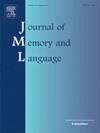Memory retrieval and prediction interact in sentence comprehension: An experimental evaluation of a cue-based retrieval model
IF 3
1区 心理学
Q1 LINGUISTICS
引用次数: 0
Abstract
Memory retrieval and prediction are typically studied separately, so little is known about their interaction. To address this gap, we studied a construction known to simultaneously trigger antecedent retrieval and possessee prediction processes: German possessive pronouns. We examined the comprehension of possessive pronouns using eye-tracking and computational modeling. Specifically, we chose an existing cue-based retrieval model that formalized prediction as a memory retrieval process. We used the model to generate predicted fixation patterns for a novel linguistic configuration, which replaced the possessive pronoun with an indefinite determiner. This allowed maintaining the prediction process—as German determiners agree in gender with a following noun—while effectively removing the antecedent retrieval process—as indefinite determiners, unlike pronouns, do not presuppose but rather introduce a new discourse referent. The eye-tracking results showed that participants’ predictions were affected by similarity-based interference, a well-known marker of memory processes. However, the timecourse of the novel determiner condition was different than predicted by the computational model. To better capture the behavioral data, we extended the model by introducing a process motivated by the semantics of indefinite determiners. Our results support the claim that linguistic predictions can be formalized as feature-driven processes that operate on representations shared by predictive and retrieval mechanisms.
句子理解中的记忆检索与预测交互作用:基于线索的检索模型的实验评价
记忆提取和预测通常是分开研究的,因此对它们的相互作用知之甚少。为了解决这一问题,我们研究了一个已知的结构,可以同时触发先行词检索和所有格预测过程:德语所有格代词。我们使用眼动追踪和计算模型来检验所有格代词的理解。具体来说,我们选择了一个现有的基于线索的检索模型,该模型将预测形式化为记忆检索过程。我们使用该模型为一种新的语言配置生成预测的固定模式,该配置将所有格代词替换为不确定限定词。这使得预测过程得以保持——德语限定词在性别上与后面的名词一致——同时有效地消除了先行词检索过程——不确定限定词与代词不同,不预设,而是引入一个新的话语指称。眼球追踪结果显示,参与者的预测受到基于相似性的干扰的影响,这是一种众所周知的记忆过程标记。然而,新的决定条件的时间过程与计算模型预测的不同。为了更好地捕获行为数据,我们通过引入由不确定限定词语义驱动的过程扩展了模型。我们的研究结果支持语言预测可以形式化为特征驱动的过程,该过程在预测和检索机制共享的表示上运行。
本文章由计算机程序翻译,如有差异,请以英文原文为准。
求助全文
约1分钟内获得全文
求助全文
来源期刊
CiteScore
8.70
自引率
14.00%
发文量
49
审稿时长
12.7 weeks
期刊介绍:
Articles in the Journal of Memory and Language contribute to the formulation of scientific issues and theories in the areas of memory, language comprehension and production, and cognitive processes. Special emphasis is given to research articles that provide new theoretical insights based on a carefully laid empirical foundation. The journal generally favors articles that provide multiple experiments. In addition, significant theoretical papers without new experimental findings may be published.
The Journal of Memory and Language is a valuable tool for cognitive scientists, including psychologists, linguists, and others interested in memory and learning, language, reading, and speech.
Research Areas include:
• Topics that illuminate aspects of memory or language processing
• Linguistics
• Neuropsychology.

 求助内容:
求助内容: 应助结果提醒方式:
应助结果提醒方式:


